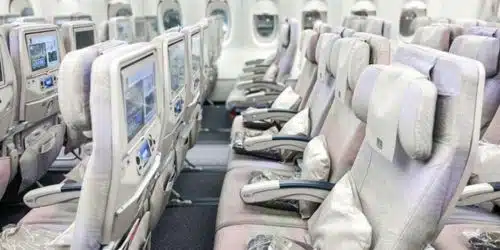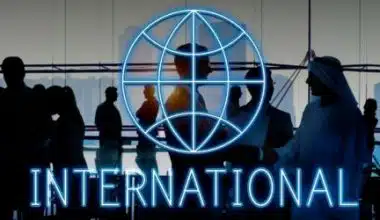Flying economy class may often feel like you’re in a jail cell in the sky, especially on long-haul flights.
There is no end to the number of ways airlines remind you of your class, from cramped seats and toilet lines to waddling past luxury business-class seats.
What is Economy Class?
Economy Class is the third and lowest class of air travel. Some refer to it as a coach, while others refer to it as cattle class, but it is the basic class. The seats are less roomy. The tickets are less expensive than those in the other classes.
The economy class on different flights varies based on the carrier. Similarly, different airlines give it different names. Passengers in this class have no right to a refund or to cancel their tickets. Passengers typically book tickets in advance to obtain lower prices. And because it is the cheapest of all the classes, it is the most popular. As a result, the seats fill up quickly.
What is Premium Economy Class?
It is an optional service provided by a few airlines. They provide superior seating options for passengers.
What are the Features of Economy Class Flights?
Depending on the airline, economy-class flights can vary. Similarly, even the name could be different. Pegasus Airlines offers three distinct economy packages: Basic, Essentials, and Advantage. Please check their website for additional information about Pegasus travel class packages.
#1. Seating
Seats in this class are fairly close together, and overhead bin space is similarly limited. In addition, passengers share the armrest. There are also 3 to 4 seats in each section. It has very little legroom.
#2. Price
It is a class for travelers on a tight budget. However, it is the least expensive way to fly. The passenger does not have to pay for the bells and whistles in this case. You just pay for the convenience of getting from A to B.
#3. Meal
Some airlines provide in-flight meals to economy-class passengers. However, the range of dishes available is restricted. Furthermore, because the food is to be served in big quantities, conveyor belts are used to make economy-class meals.
#4. Programs for Distributing Flyers
Frequent flyer programs provide more limited advantages to economy-class travelers. Some of these advantages include earning and redeeming points for flights, as well as receiving unique discounts, incentives, and offers.
Do you know? The first class was the starting point for all airlines. Delta Airlines devised the concept of boarding more passengers.
What is Business Class?
Business Class is the second-tier class on an airplane. It is the middle ground between economy and first class. Nonetheless, several airlines provide business class as their highest degree of service.
Business class tickets provide travelers with larger seats, fine dining, and other perks. Essentially, you are paying extra money for VIP treatment in business class. And all of this comes at a high cost.
#1. Seating
Seating in economy class is smaller than in first class, but larger than in first class. So there’s plenty of room to stretch out and unwind. It also has a recliner, a totally flat cabin, and angled lie-flat seats. Business Class seats have extra legroom. There is a television screen for business-class customers. There are also four restrooms for a limited number of people.
#2. Price
Business Class tickets are pricey. They are just three times the price of Economy Class, but less than First Class. There are special business class check-in counters at the departing airport, which are less busy.
#3. Lounge Facilities
It also grants you access to the airport lounge, where you may relax and work before your departure. The quality of the lounge, however, varies depending on the airline you are flying with and the airport terminal from where you are departing.
#4. Meal
When it comes to food, there are more selections on the menu. Workstations are typically used to create tray seats for passengers.
#5. Priority Check-in
The bags of business class travelers can be checked in ahead of time. This indicates they will be the first to arrive. In addition, business class customers earn more frequent flyer miles on the same voyage.
#6. Programs for Distributing Flyers
Business Class travelers receive a variety of incentives through frequent flyer programs. They are eligible for advancement. They are also entitled to free flight modifications and cancellations.
Do you know? In 1979, Qantas was the first airline to offer separate cabins for business class passengers. This concept was adopted by other airlines. As a result, 3-class treatment on long-haul flights has been commonplace since then.
Key Distinctions Between Economy and Business Class
Economy Class is the most basic class of air travel. It is ideal for customers on a tight budget. This allows for long-distance travel at a reasonable cost. On the other hand, there is Business Class, which is a significant improvement over the economy. It not only provides pleasant seating and professional service, but it also serves dishes prepared by a celebrity chef.
- A multi-course meal is typically offered in a business class. However, economy-class passengers are simply served a single-tray lunch.
- The price of business class is over three times that of economy class. However, there are certain benefits to purchasing business-class tickets.
- Customers in Economy Class must board flights from a long line. On the other side, there is a separate counter for Business Class passengers to board less congested planes.
- Business class travelers get higher luggage allowance than economy class passengers.
- Seats in Business Class are broader. It may also be expanded, allowing you to lie flat on the seat. However, the seating in economy class is the narrowest of all. It is also generally crowded due to its low pricing.
How To Fly Economy Class While Feeling Like You’re In Business Class
Following the announcement of new economy-class sleep pods by Air New Zealand, we look at additional methods to make a lengthy flight in the cheaper seats more tolerable.
With rising costs, it is more important than ever to be aware of the various ways you might upgrade an economy seat.
Here are some tricks to make you feel like you’re flying business class in economy.
#1. Going Neighborless
Etihad Airways’ “neighbor-free” policy is one semi-luxurious alternative for long-haul flights.
Essentially, passengers can submit bids to ensure that the one or two seats next to them remain open, giving them the entire row to themselves.
The bid can be submitted when purchasing your seat, and Etihad will disclose a minimum and maximum bid with you based on your trip and destination, with regular travelers given preference.
Winners of the auction will be notified 32 hours before the aircraft departs, and while Etihad does not have precise costs, it might be a less expensive method to have more room on a long-haul flight.
Qantas is also offering a similar neighbor-free scheme, with the airline contacting eligible travelers on select Qantas-operated Australian domestic flights.
One extra seat on an Etihad trip from Sydney to Abu Dhabi in June will cost A$187, while two seats will cost A$373. Additional seats on each aircraft of a multi-leg trip can be bid on, so expenses can pile up, but who can put a price on comfort?
#2. A sofa in the sky
Air New Zealand launched Skycouch late last year, allowing passengers to book up to three economy seats that fold out into one giant sleeping space, similar to a couch.
The Skycouch, which is 1.55 meters long and 74cm broad, can accommodate up to two adults and a kid in various configurations.
For infants under the age of two, the airline will additionally provide an infant harness and belt.
Prices vary depending on the location and duration of the flight. You do not pay the entire price for all three seats; instead, rates are determined by the number of persons who will use the Skycouch.
On a voyage from Los Angeles to Auckland, for example, a Skycouch will cost an additional $1,300 per customer on top of your ticket price.
It comes as the airline prepares to launch a rentable bunk-bed cabin, which can be reserved for up to four hours and costs between NZ$400 and NZ$600 (US$250 and US$380).
The mattresses are suspended a few feet apart from their co-sleepers, and the pods are not completely enclosed, though guests will be sheltered from their co-sleepers by a privacy screen.
The drawback is that you can only reserve them for four hours, so you’ll have to get down and join the rest of your fellow passengers at some time; there’s no choice for an eight-hour snooze.
#3. Auctions for Space
Several airlines hold online auctions for empty business-class tickets, giving economy travelers the opportunity to upgrade at a modest fee.
Qantas, with its “bid now upgrades” scheme, Virgin, through its “upgrade premium bid,” as well as Malaysia Airlines, Etihad Airways, and Cathay Pacific, all offer passengers the opportunity to bid on upgrades on select flights.
The offers are often restricted for a limited number of passengers who are notified through email, with minimums and maximums routinely shared to minimize unrealistic bids.
#4. Premium class
There is also the expanding option of a “premium” economy seat, which provides travelers with a bit more service for a little more money.
Each seat provides a little more legroom, more comfortable chairs, and a broader recline angle, with some also providing premium food options, greater baggage allowance, or better entertainment options.
It’s not exactly business class, but it will help long-haul flights.
Prices vary depending on travel time, destination, and airline, with domestic premium economy seats being less expensive than long-haul.
Emirates won the best premium economy seats in the 2022 Skytrax World Airline Awards, followed by Virgin Atlantic, Delta, Air New Zealand, Singapore Airlines, and Qantas in sixth place.
Prices vary depending on airline and destination, but a journey from Sydney to London on Emirates premium economy in August costs A$3,416.75, compared to A$1,330.75 on the economy.
#5. Gadgets
Finally, if skybeds and seat auctions are unavailable, there are strange-looking transport contraptions.
You can get a neck pillow, but you can also get a foot strap to lift your feet, an inflatable footrest to lay between seats, or even an inflatable travel cushion to lean against.
Of course, there are now all-encompassing neck pillows available, allowing you to be engulfed in relaxation while ignoring reality and how you look.
There are a variety of options here if you want to fully overlook how you’d look, from this napping cushion to this headset-like pillow.
What is the Difference Between an Economy and a Premium Economy?
The difference between economy class and upgraded premium economy classes on international flights varies by airline, route, and plane type.
In some circumstances, these seats are quite identical to standard economy seats, but with a few inches more recline, legroom, and seat breadth. They may be in the front of the main cabin, but not in their own area. United’s Economy Plus, Delta’s Comfort +, American’s Main Cabin Extra, and JetBlue’s Even More Space are all popular examples. Priority boarding, complimentary alcoholic beverages, and a larger snack selection are all possibilities. Some offer a complimentary checked bag as well as specific overhead bin space.
Other premium economy variants are a significant step above standard economy. The chairs may have improved headrests, seat pitch, and footrests, providing more legroom and comfort than the economy (though not quite as nice as business or first class). They are occasionally housed in a separate cabin and have their own allocated bathrooms. This fare class may also include luxuries like a distinct food and beverage selection, dedicated flight attendants, larger entertainment screens, and amenity packages. Long-distance flights are frequently reserved for aircraft with premium economy cabins. British Airways World Traveler Plus, Delta’s Premium Select, JAL’s Sky Premium, United Premium Plus, Virgin Atlantic, and Virgin Australia’s Premium classes are all examples.
However, on local and short-haul flights, the premium economy is often fairly similar to the economy in terms of service and seats, with slightly more legroom and recline.
What’s the Difference Between an Economy and a Basic Economy?
The price difference between economy class and the discounted basic economy class varies according to the airline, route, and plane type. Basic economy is often an airline’s cheapest fare class.
The seats are the same as the regular economy and are placed in the same cabin, but the ticket does not include many of the regular economy features, such as advanced seat allocations and gratis upgrades depending on airline loyalty status. Passengers in basic economy earn fewer loyalty points, have stricter limitations on carry-on and checked bags, and board last.
Can I Select My Seats When Purchasing an Economy Ticket?
Most airlines enable standard economy passengers to select their seats during the booking process, while some seats, such as exit rows and bulkheads, may be subject to additional surcharges. Some airlines, particularly low-cost carriers, may charge economy passengers to select their seats ahead of time, regardless of seat position.
With an Economy Ticket, Can I Bring Checked Luggage?
Checked luggage allowances vary widely depending on the airline, route, season, and status in an airline loyalty program. Some airlines give economy passengers one to two free checked baggage each way on international flights, however, most airlines charge economy passengers to check luggage on domestic flights, with rates ranging from $30 to $60 per bag each way.
Some low-cost airlines, such as Norwegian, charge passengers per leg (for example, if your itinerary involves a layover, you must pay extra checked luggage fees).
With an Economy Ticket, Can I Bring a Carry-on Bag?
Most airlines provide one carry-on bag and one personal item, such as a laptop bag, knapsack, or handbag, free of charge to normal economy customers, though this policy varies depending on carrier, route, and plane type.
Long-haul flights normally enable regular economy travelers to bring a full-size carry-on bag along with their personal items, while some budget carriers demand a fee regardless of route length for a full-sized carry-on bag. Smaller personal stuff is nearly typically complimentary.
Are Food and Drink Included With an Economy Ticket?
The availability of food and beverages for economy travelers varies depending on the airline and route. Most legacy airlines provide complimentary soft drinks and a modest snack such as peanuts or crackers on short and medium-haul flights; more substantial meals and alcoholic beverages are available for purchase.
Many major airlines provide a free hot meal and a heartier snack, as well as soft drinks and some free alcoholic beverages, with an economy class cost on long-haul flights.
Other airlines, particularly low-cost carriers, charge economy customers for all beverages, regardless of route length.
Which Airline Has the Best International Economy Seats?
While economy conditions vary depending on the plane and route, five-star airlines typically have some of the most comfortable seats.
All economy class seats on Singapore Airlines’ newer long-haul aircraft, such as the Airbus A380 and Boeing 777-300, have 32-inch pitch, cushioned six-way adjustable headrests, HD seatback entertainment touch screens ranging from 10 to 11 inches, built-in smartphone storage, and both USB ports and power plugs for charging.
All Nippon Airlines (ANA) in Japan is also notable for its enhanced economy-class amenities. Several of the airline’s latest models feature fixed-back shell seats in economy class (which recline by sliding into themselves rather than crowding the passenger behind them), as well as charging USB ports and AC power connections. The majority of ANA economy class seats have a massive 34-inch pitch, and some plane types additionally include footrests for added comfort.
JetBlue provides one of the greatest economy class experiences for short and medium-haul international flights, with a large choice of complimentary refreshments, live in-seat TV, and free WiFi on every aircraft. Several of their planes have a 32-inch pitch in the economy cabin, while their newest Airbus A320 has a full 34-inch pitch.
Conclusion
Nowadays, every airline has an economy class. It is the most convenient alternative for short flights. Economy class tickets are the greatest option for travelers who prioritize price. However, if you want a comfortable or pleasurable flight, business class is the way to go.
- 21 TOP BUDGET TRAVEL TIPS
- BEST VOLUNTEER ABROAD PROGRAMS FOR 2023
- EMBARKATION PORT: Definition and All You Need To Know
- HOW TO CALCULATE AIRBNB FEES FOR HOST: All You Need To Know
- HOW TO TRAVEL WITH A DOG: Detailed Guide






